 |
||
|
||
| ||
 Today we will examine one more batch of video cards based on the NVIDIA GeForce4 MX. We have received cards based on the MX 460, one card on the MX 440 and a hybrid - a card on the MX 440 but with the MX 460's memory. Today we will also analyze how the performance of these video cards changes with regard to the CPU's frequency and platforms. But first of all, take a look at the articles of already reviewed cards based on the GeForce4 MX. Theoretical materials and reviews of video cards which concern functional properties of the NVIDIA GeForce4 MX GPU
In the first review in the list we described the GeForce4 MX family in depth. I just want to say that this family is meant for mainstream market, i.e. for users who want a video card cheaper than $100-120. As it often happens, the prices for just appeared MX 460 are over $120. But I think by June they will fall down, because there are GeForce4 Ti 4200 cards available at $170 for 64 MBytes model. I think you understand that the difference between them is huge although the memory size is the same. You should also remember about GeForce3 cards (Ti 200/500) which are widely available on the market. The cheapest (Ti 200) has a more attractive price than the MX 460 despite wider 3D capabilities. That is why I think that the whole GeForce4 MX line will be up to $100. But is it worth buying new castrates instead of old GeForce2 Ti/Pro? As you know, prices for the old ones have fallen down considerably to the level of $50. The only thing that the MX has is a new kind of AA (Quincunx, 4xS) and a dualhead support of the MX 460. That is why you should carefully examine 3D performance scores, compare prices and account for the dualhead support. Especially it concerns those users who are going to get new cards for their old cases the power of which is often low. Today we will test the GeForce4 MX on the Pentium 4 2.2 GHz platform (evidently, this processor doesn't limit the performance of such cards :-)) and on the Pentium III 1.0 GHz (i815). There are quite interesting samples among the tested cards. For example, the Leadtek's one which is an intermediate stage between the MX 440 and 460. Or the Triplex's card which has a silver-covered PCB. I guess you know Leadtek, Gainward and AOpen quite well, while Triplex was spoken about in the GeForce3 Ti 200 and GeForce4 Ti 4600 review. CardsAll cards have an AGP x2/x4 interface, 64 MBytes DDR SDRAM located in 4 chips on both sides of the PCB.
The first two cards are as like as two peas: they differ only in the PCB color and in coolers. Both are based on the reference design. The Leadtek GeForce4 MX 440 card is assembled on the MX 460's PCB and comes with the same memory in the BGA package with 3.6ns access time. Unlike the dualhead MX 460 card, this one doesn't have a DVI connector. This hybrid is going to replace the earlier released simple MX 440 cards, that is why it must be available at $100-120. The Triplex's product is a copy of the MX 440 reference sample, with the PCB covered with a thin silver layer. In the Triplex Millennium Silver GeForce4 Ti 4600 review I said that this technology is used to reduce effects of various pickups and decrease the overall temperature of the card which is heated up mostly by the chip. But note that I didn't test its effectiveness, maybe I will do very soon. As you already know, all modern cooling devices are real pieces of arts on which the talented designers and artists spend hours. Of course, it doesn't concern all cards, but their quantity keeps on growing.
As you can see below, the AOpen and Gainward cards come with the GeForce4 MX 460 GPUs: 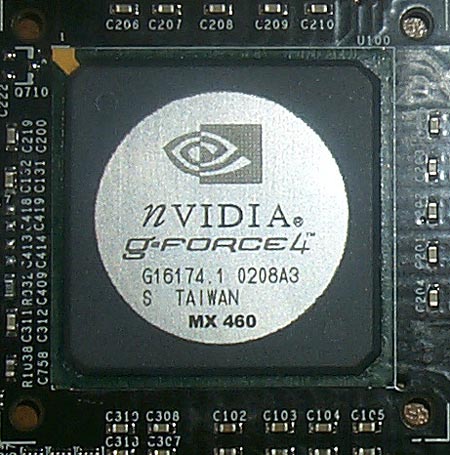 The Leadtek WinFast A170 DDR T has a MX 440 processor:  That is why this card is referred to the MX 440 class despite its design. The cooler of the Triplex card is attached to the chip so rigidly that I decided not to take it off because of possible damage. The MX 460 cards have VGA and DVI connectors. They have a normal nView support, including TV-out. However, the AOpen and Gainward cards are also equipped with the VideoIn (VIVO) via Philips 7108: 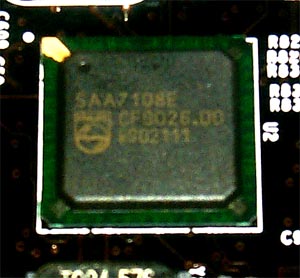 The VideoIn comes with the following software CyberLink Power VCR for the AOpen's card which can record a video stream in MPEG1, AVI (with a standard suite of compressions); Gainward offers InterVideo WinCoder/WinProducer which has wider capabilities for operation with a video stream. The TV-out of the MX 440 is realized using the GPU's capabilities. However, the Triplex card doesn't have an S-Video-to-RCA adapter, and you won't be able to display images on a TV screen through RCA. By the way, let's pop into the boxes and see what's inside: All cards ship in the retail package. Overclocking
The Gainward has the best overclocking potential (it was expected as this company selects components for its Golden Sample series itself). The potential of the Triplex card is limited by the Samsung's memory which is always hard to overclock. Note:
 Test system and driversHere we examine how the accelerator's performance depends on a CPU frequency (and on a platform), that is why we used two test stands:
The test system was coupled with ViewSonic P810 (21") and ViewSonic P817 (21") monitors. In the tests we used NVIDIA's drivers of v29.40. VSync was off, S3TC was off. For the comparative analyses we used the following cards:
Both MX 460 based cards show identical results in all tests, that is why we spare you from the same bars: we marked the scores of both cards as NVIDIA GeForce4 MX 460. Test resultsBefore I estimate 2D quality I must warn you that at present there is no a complete technique of objective estimation of this parameter because:
We can found something like a lab of experts for estimation of quality of an output signal of your cards. But to get more or less objective estimation it's necessary to collect pleanty of data on different cards, which is impossible. That is why 2D quality is not kept track on here. Of course, we try to do our best to improve this situation, but I can't promise anything now. As far as the tested samples are concerned, I can say that together with the ViewSonic P817 monitor and a BNC Bargo cable they showed excellent quality at the following resolutions and frequencies:
For estimation of 3D quality we used:
In our 3Digest you can find detailed information on performance of the MX 440 cards as they include a lot of tests (I especially recommend that you look through the anisotropy section). The tests were carried out in the 32bit mode. 3D Mark2001 SEGame1 Low Details 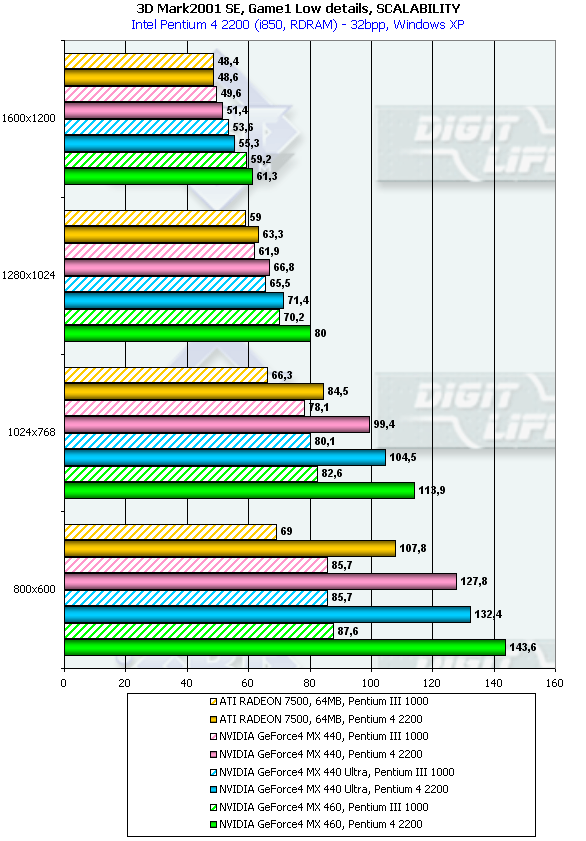 This test shows that the GeForce4 MX 460 is really a leader. Even the GeForce3 Ti 200 falls behind it. But you should remember that the Game1 is very processor-intensive, especially in 800x600 and 1024x768. Game2 Low Details 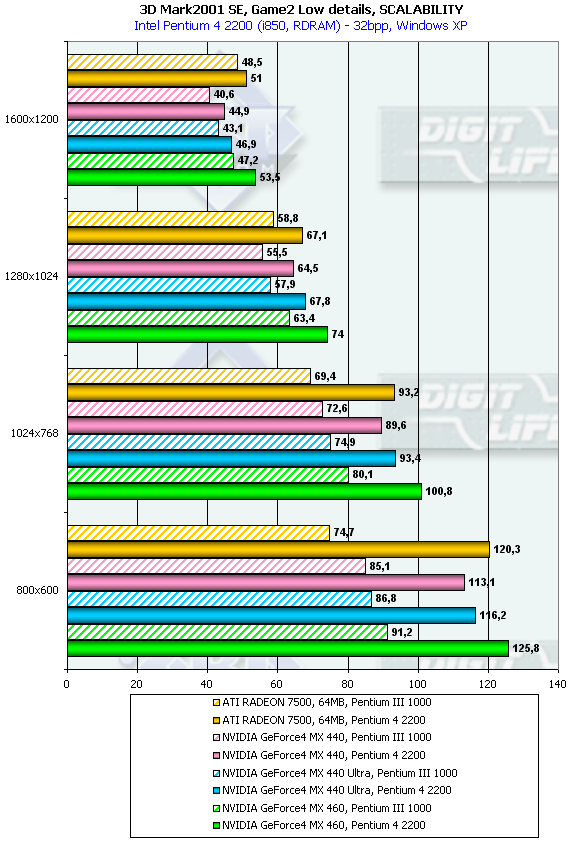 This test forwards those cards which support memory optimization: RADEON 7500 and GeForce3 Ti 200. Although the MX 460 has the same optimization, the low fillrate makes the effect. The Game2 is the least processor-dependant test in the 3DMark2001 package. In the low resolution the gap between the contestants is greater on the more powerful platform. Game3 Low Details 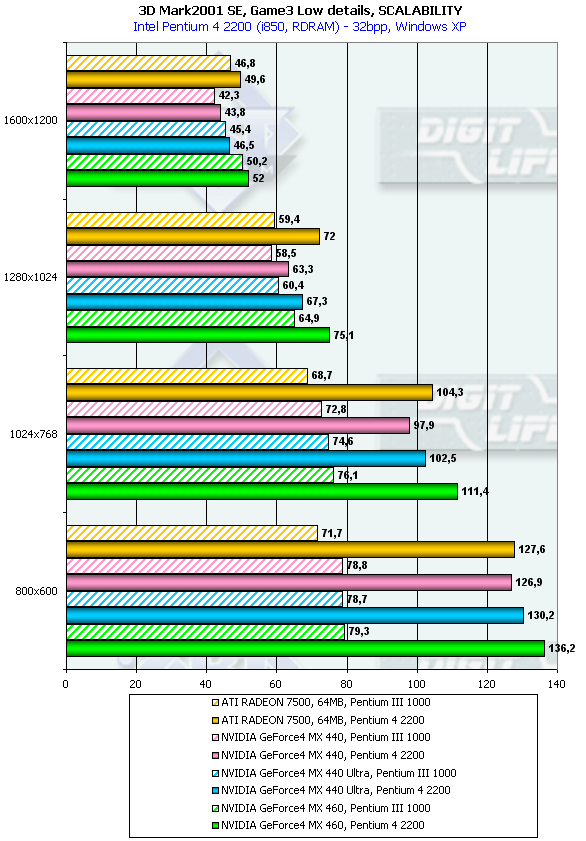 Here the RADEON 7500 outscored the MX 440 cards and caught up with the MX 460. Remember that we use the fastest variation of the RADEON 7500 produced by ATI which has a relatively high price, while the cheaper RADEON 7500 cards work at lower frequencies. By the way, all these comparisons are included in our 3Digest. 3D MARKS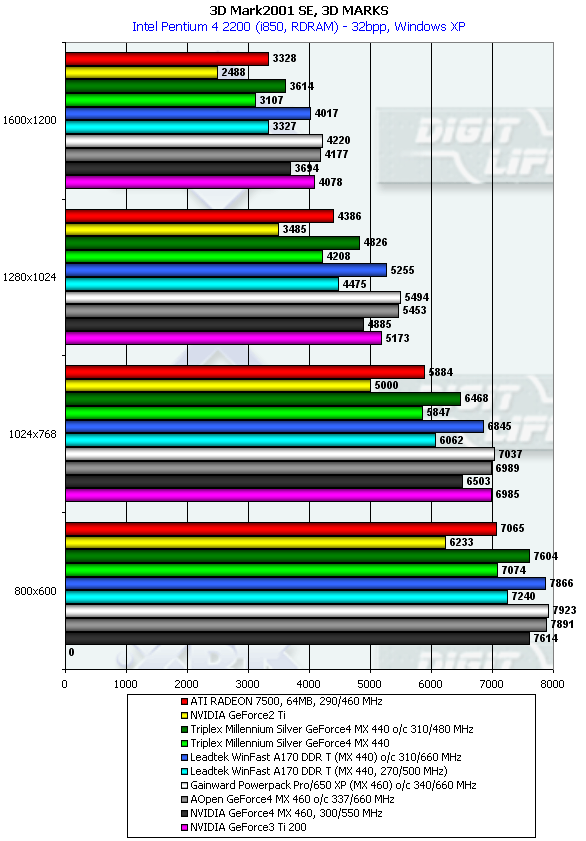 The MX 440 based cards go on a par with the RADEON 7500 and stomp the GeForce2 Ti into the ground (the Leadtek's card with the increased memory speed outedges the ATI's model in low resolutions, the Triplex's card is a little behind). The MX 460 loses to the GeForce3 Ti 200, but the overclocking makes them faster, and sometimes the Ti 200 is not able to keep its leading position. ConclusionWe have tested 4 interesting video cards. Each of them has both advantages and disadvantages. First of all I must say that the GeForce4 MX 440 based cards can be excellent substitutes for the aging GeForce2 Ti, if it were not much reduced prices for such cards. However, their production is completed long time ago, that is why only the ATI RADEON 7500 can be an alternative for the MX 440. But with this card (RADEON 7500) there are a lot of problems in estimation of its speed properties because nobody knows at which frequencies one or another RADEON 7500 sample works. As for the MX 460, this is a good choice for those who don't need a so modern support of pixel shaders, but who wants dualhead and VIVO.
The complete characteristics of video cards of this and other classes can be found in our 3Digest. Highs:
Lows:
Write a comment below. No registration needed!
|
Platform · Video · Multimedia · Mobile · Other || About us & Privacy policy · Twitter · Facebook Copyright © Byrds Research & Publishing, Ltd., 1997–2011. All rights reserved. | |||||||||||||||||||||||||||||||||||||||||||||||||||||||||||||||||||||||||||